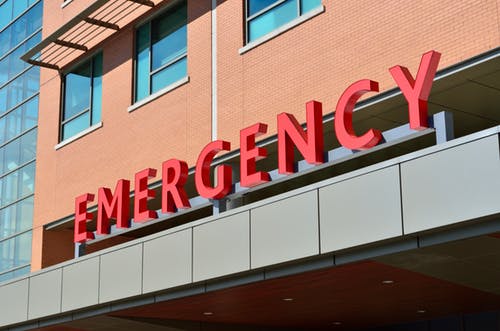What Do I Mean When I Say, ‘Your Doctor Won’t Cure You’? I mean our medical system won’t save you from a lifetime of harmful behaviours and not for the reason you may think I am going to give (the old spiel about ‘by the time you need medical intervention it is too late’ because while this is true to a degree we know many illnesses are reversible if the right treatment is eventually taken) rather it is because our medical system is designed to cure a limited range of issues, specifically those which are acute and purely physiological and the reality is not all illnesses fit this criteria. Therefore, unless you have an illness which does the simple fact of the matter is you will need alternative treatment to be successful in reaching your health goals.
Doctors Are Part of (Not Your Sole) Treatment

Doctors are trained to treat disease and illness. Doctors are trained to treat the problem now, not necessarily to look at the long term and underlying causes and certainly not to invest the time and energy it would take to empower you to change these within the context of your everyday life. The reality is they are not trained to foster wellbeing and promote optimal health which is neither good nor bad because this form of health care without argument has its purpose however, where this becomes damaging is when the scope of the doctors role is ignored and we place the expectation upon the doctor or medical system to fix us in a way it was never intended to.
A Common Story

You or someone close to you may have experienced the limitations and constraints of our current medical system as you sought treatment, answers and cures for a disease or illness which required more in depth, long term or holistic treatment than the traditional medical model could provide. This is a common story yet for the most part even when faced with the evidence that the medical system is not meeting our health needs we continue to cling to the false belief that doctors, and hospitals are the places which hold all the answers therefore it is our own inaccurate beliefs that are preventing us from getting the help we require because the complimentary health care options are available.
It’s Up to Us

Our medical model has evolved to effectively meet the needs of treating acute illness and injury because most of our health challenges up until recent years have been related to acute illness and injury. However, this is no longer the case and the real threats facing society today are rapidly moving away from acute and contagious illness (such as measles, mumps and rubella) and towards a growing incidence of chronic and noncommunicable illnesses (such as diabetes, heart disease and mental health issues such as depression) aside from this many of us simply want and are in a position to expand our health into not just the absence of disease but the experience of wellbeing.
What this change in health focus means is that the past and current medical model cannot meet these needs and therefore either of two things must happen for our health care to continue to be effective;
- The medical system as we know it must change
or
- We make better use of ‘alternative’ treatments alongside and which complement the traditional medical model.
The second of these two options is the higher value because it is easier, most realistic allows for the quickest delivery of help where it is needed and it is indeed what is naturally happening. However, the transition and reach of people being proactive in seeking other forms of health care alongside traditional medical services is slow and often still not viewed as being as of as high value when compared to ‘the doctor’ and this misconception is coming at an incalculable cost to our health and wellbing. Therefore, it’s up to you and me to speed up this update and take leadership of our health outcomes purely through our choices.
Beyond Prevention and Treatment to Cure and Wellbeing

Our current medical system is designed to patch you up and send you right back into the same environment, life and thoughts which manifested the problem in the first place with tremendous emphasis on ‘achieving’ this outcome as quickly as possible.
What this means is that you can in actuality be unnecessarily prescribed ‘treatments’ such as medication or surgery which won’t do anything to fix the underlying cause of the problem and what is becoming evident is that if we are not treating the cause it will continue to arise and manifest in different or the same ways until we do address it or until you die with (or from) it. The doctor might know how to make it better ‘now’ (possibly with a menagerie of side effects) but what they are less likely to be able to help you with is becoming aware of and addressing the true cause of the problem which is the only way you can experience a cure rather than temporary relief.
Most of us want to go beyond treatment of disease, we want to be happy and live meaningful and fulfilling lives and there are many professionals who can help make this a reality for you including health coaches, occupational therapists, physiotherapists, dietitians, psychologists, clinical hypnotherapists and so on. What you have to remember is that these people get to spend greater time with you than your General Practitioner (GP) therefore they have greater time to get to know you and your goals and this is where the magic lies because your capabilities are far more important than your diagnosis, age, gender, ethnicity or any other category of generalised treatment you could ever be placed into.
What It All Means
The level to which our modern-day medicine has evolved is truly miraculous and without question has an invaluable and irreplaceable role in health care, but the truth remains that it is largely designed for retrospective care and often management of illness rather than patient empowerment or advancing wellbeing and you must understand that doctors and the medical system at large were never designed to and therefore cannot be expected to meet all your health needs.
The moment you understand the different roles of different health care professionals is the moment you can take leadership of your health and begin to make informed choices to stop investing your hope and looking for help in the wrong or less effective places and instead invest your money, time and energy in the help that is right for you and most importantly begin to move towards achieving the outcomes you want! It’s that simple.
Ps. Final Push for Those Still Set on Being Saved By the Doctor

Iatrogenic deaths are estimated to be responsible for between 44 000 to over 400 000 deaths per year in the US alone1-8 which translates to being the third leading cause of deaths furthermore less than 10% of medical errors are recorded9. For a reminder of what iatrogenic deaths are, they are deaths caused as a result of medical examination or treatment (note: it is generally cited that iatrogenic deaths in Australia, Germany, Canada and the UK are lower than the US however, I could not find reliable figures).
While statistics cannot covey the experience of each individual human life behind these numbers to me these statistics are a huge motivation to seek help that can empower you to take leadership of your health and recognise that while the hospital and doctors are a valuable part of they are not your sole or even necessarily your best place for health progression depending on your condition and goals
With my whole heart I hope you found this information useful and inspiring

Become Great. Live Great.
Bonnie.
- Brennan TA, Leape LL, Laird NM, et al. Incidence of adverse events and negligence in hospitalized patients. Results of the Harvard Medical Practice Study I. N Engl J Med. 1991;324:370-6.
- Thomas EJ, Studdert DM, Newhouse JP, et al. Costs of medical injuries in Utah and Colorado. Inquiry. 1999;36:255-64.
- Leape LL, Lawthers AG, Brennan TA, Johnson WG. Preventing medical injury. Qual Rev Bull. 1993;19:144-9.
- HealthGrades quality study: patient safety in American hospitals. 2004. [Online] Available from:http://www.providersedge.com/ehdocs/ehr_articles/Patient_Safety_in_American_Hospitals-2004.pdf.
- Department of Health and Human Services. Adverse events in hospitals: national incidence among Medicare beneficiaries. 2010.
- Classen D, Resar R, Griffin F, et al. Global “trigger tool” shows that adverse events in hospitals may be ten times greater than previously measured. Health Aff. 2011;30:581-9.
- Landrigan CP, Parry GJ, Bones CB, Hackbarth AD, Goldmann DA, Sharek PJ. Temporal trends in rates of patient harm resulting from medical care. N Engl J Med. 2010;363:2124-34.
- James JTA. A new, evidence-based estimate of patient harms associated with hospital care. J Patient Saf. 2013;9:122-8.
- Anderson JG, Abrahamson K. Your Health Care May Kill You: Medical Errors. Stud Health Technol Inform.2017;234:13-17.



